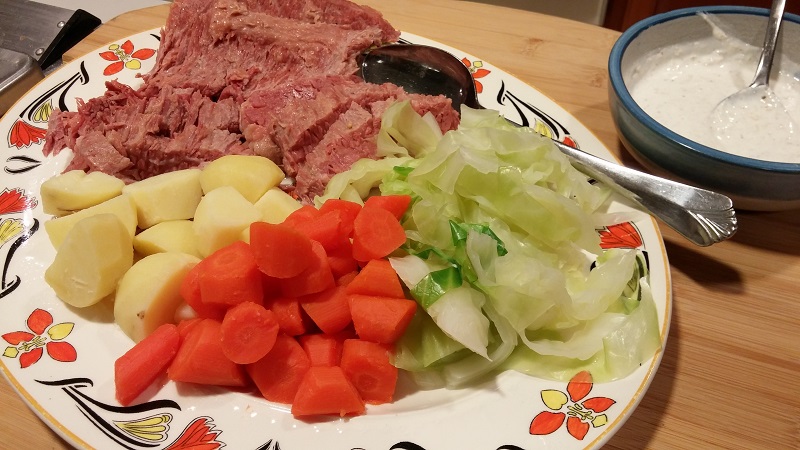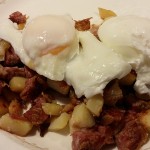New England Boiled Dinner, just like our hardy New England forefathers, is substantial, simple, straightforward and generous with the kind of hearty utility found in L.L. Bean boots. Early Americans needed a practical method of meat preservation and a flavorful preparation of winter root vegetables to sustain them through the cold months. The corned beef boiled dinner was the answer!
The boiled dinner was well established when Irish immigrants, who had traditionally eaten brined pork rather than expensive beef, adopted it as their mainstay. Today, it’s just the thing for St. Patrick’s day, but not often seen the rest of the year. Supermarket bins are overflowing with corned beef now, but in a few weeks you’ll have to rummage around to find any. Too bad. This important meal from our New England heritage is delicious, easy to prepare, and good any time.
Corned beef, usually brisket, is the centerpiece of a boiled dinner. Any cut of beef, or pork, for that matter, can be corned. The process is fairly simple: soak the meat in a salt brine with pickling spices. The term corned refers to large kernel-sized grains of rock salt called corns that were used to make the brine. No actual corn is involved. The spice blend can be tweaked for desired flavor, but the basics are peppercorns, mustard and coriander seeds, allspice, cinnamon and mace. Some recipes call for bay leaves, pepper flakes and ginger as well. It was easy for farmers to do themselves – preserving their meat for future use. Food author Michael Ruhlman in his book, Charcuterie, has an easy recipe if you want to give it a try.
The corning of meat was an important preservation technique before refrigeration. Ireland was a supplier to England and the British navy at the height of the Empire. Barrels of beef in brine were a common site on the docks and in the cities, spreading a taste for corned beef around the world.
I can imagine the cast iron pot simmering on the hearth overnight or all day long, an efficient and low maintenance way to put on a hearty meal. Vegetables from the root cellar – parsnips, carrots, turnips, cabbage, or rutabagas – were added as the meat cooked. Potatoes were an innovation from the Irish as they adopted the dish. Beets could be included, too, but cooked separately to avoid coloring everything red. Today the long slow simmer can be easily duplicated on the stovetop or in a crock pot. No fuss or careful timing with this preparation.
There are lots of different recipes for a boiled dinner, but the basics are the same: simmer the meat with some spices, boil the vegetables, slice and serve. (Corned beef from the supermarket usually includes a spice packet and cooking directions.) However, the wisdom is divided on how to do the vegetables: cook them in the pot with the meat or separately. The old timers used one pot, adding the vegetables towards the end. This makes sense, but would require a good deal of experience to achieve a common vegetable cooking time (like handicapping a horse race). Practice makes perfect.
I’d rather cook the vegetables by themselves. Corned beef is by definition salty, and the salty broth can overwhelm the veggies. With each in its own pot, I can control cooking time, seasoning, and doneness. To keep things under control, my usual limit is three vegetables: carrots, cabbage and potatoes. I like to cook the cabbage till it’s a little crisp and keeps a bright green color. For my money, the vegetables all need some butter melting over them for the best flavor.
The other debate on Boiled Dinner concerns onions – some want them, others do not. Feelings can be quite strong on both sides of this issue. Personally, I don’t like the smell of boiled onions, so it’s easy for me to skip them.
Corned brisket is prepackaged as flat cut or point cut. The flat is larger and more uniform in shape, but will feed a crowd. The point is a long skinny irregular triangle, smaller so it will feed fewer and cook more quickly, but not as pretty at the flat.
A boiled dinner is great served family style: slice the brisket onto a platter and surround it with the vegetables for a steaming colorful show. To take it up a notch, make a sauce with sour cream, horseradish, and ground black pepper.
One of the principal benefits of a boiled dinner is the leftover corned beef- the foundation of another New England
staple – Corned Beef Hash. Take some leftover diced corned beef and potatoes, add some onion, sweet pepper, cream or stock, and a little seasoning. Slow cook it in a skillet to form a crisp crust and top with a poached egg. Magic can happen! By adding diced beets (canned are OK) you have the means to make Red Flannel Hash, that most New England use-it-up leftover. Including beets in the hash gives it a distinctive red checkered appearance – like a bright, warm, flannel shirt.
A New England Boiled Dinner is great in March to celebrate St. Patricks Day and mark the passing of Winter. But keep it in mind year round, for a time-honored dinner with the bonus of great leftovers.













No Comment